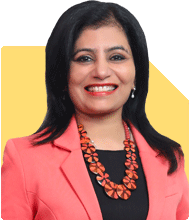Should I close my remaining home loan (23 instalments) or invest the lump sum in SWP?
Ramalingam Kalirajan |8077 Answers |Ask -Follow
Mutual Funds, Financial Planning Expert - Answered on Aug 13, 2024
He has an MBA in finance from the University of Madras and is a certified financial planner.
He is the director and chief financial planner at Holistic Investment, a Chennai-based firm that offers financial planning and wealth management advice.... more

I am male 48 & My wife is 44. Our combined income is 2.4 lpm. Our expenses is almost 2.7 lpm including Home loan emi of 70k. Investment is 70kpm. Should I close Home loan 13 lakh outstanding (23 instalments) and divert the emi amount in savings? Or should I invest the lumsum 13 lakh in SWP?
Your combined income is Rs 2.4 lakhs per month. Your expenses are Rs 2.7 lakhs, including a Rs 70,000 home loan EMI. You’re also investing Rs 70,000 per month. This shows strong financial discipline, but the gap between income and expenses is concerning.
Evaluating the Home Loan Repayment
You have Rs 13 lakhs outstanding on your home loan with 23 installments left. Paying off this loan early has both pros and cons.
Benefits of Repaying the Loan Early:
Interest Savings: You save on the interest you would have paid over the remaining installments.
Debt-Free Living: Being debt-free can reduce financial stress. It also frees up Rs 70,000 per month.
Drawbacks of Early Repayment:
Opportunity Cost: You might miss out on potential higher returns if you invested this amount.
Liquidity Impact: Using Rs 13 lakhs to close the loan reduces your liquid savings.
Considering the SWP (Systematic Withdrawal Plan)
Investing Rs 13 lakhs in a SWP can provide regular income and potential capital appreciation. However, it’s essential to understand the pros and cons.
Benefits of SWP:
Regular Income: You get a steady income stream, which can supplement your monthly cash flow.
Capital Growth: Your investment has the potential to grow, giving you more value in the long term.
Drawbacks of SWP:
Market Risk: The returns depend on market performance, which can fluctuate.
Not Debt-Free: You’ll continue paying the home loan EMI, which could strain your cash flow if the market underperforms.
Cash Flow and Expense Management
Your current expenses exceed your income by Rs 30,000. This is manageable now, but it’s not sustainable in the long run.
Prioritize Debt Repayment: Paying off the home loan can reduce your monthly outgoings by Rs 70,000, giving you breathing room.
Emergency Fund: Ensure you have an emergency fund that covers at least six months of expenses.
Deciding Between Loan Repayment and SWP
Your decision should align with your financial goals and risk tolerance.
If You Prioritize Security:
Repay the Home Loan: This eliminates a significant monthly expense and provides peace of mind. It also improves your monthly cash flow by Rs 70,000, which you can then redirect towards savings or investments.
If You Prioritize Potential Growth:
Invest in SWP: This can provide regular income and the possibility of higher returns. However, be prepared for market fluctuations and ensure you have a backup plan if the returns are lower than expected.
Final Insights
Given your current situation, repaying the home loan could be a safer option. It will reduce your monthly expenses, eliminate debt, and provide more flexibility in your finances. If you prefer taking calculated risks, consider the SWP option but ensure you have a solid plan to manage your cash flow.
Best Regards,
K. Ramalingam, MBA, CFP,
Chief Financial Planner,
www.holisticinvestment.in
You may like to see similar questions and answers below
Ramalingam Kalirajan |8077 Answers |Ask -Follow
Mutual Funds, Financial Planning Expert - Answered on May 06, 2024
Milind Vadjikar |1086 Answers |Ask -Follow
Insurance, Stocks, MF, PF Expert - Answered on Oct 04, 2024
Ramalingam Kalirajan |8077 Answers |Ask -Follow
Mutual Funds, Financial Planning Expert - Answered on Oct 17, 2024
Ramalingam Kalirajan |8077 Answers |Ask -Follow
Mutual Funds, Financial Planning Expert - Answered on Feb 03, 2025
Inderpaul Singh |43 Answers |Ask -Follow
Leadership Coach - Answered on Mar 05, 2025
Anu Krishna |1544 Answers |Ask -Follow
Relationships Expert, Mind Coach - Answered on Mar 05, 2025
Anu Krishna |1544 Answers |Ask -Follow
Relationships Expert, Mind Coach - Answered on Mar 05, 2025
Anu Krishna |1544 Answers |Ask -Follow
Relationships Expert, Mind Coach - Answered on Mar 05, 2025
Anu Krishna |1544 Answers |Ask -Follow
Relationships Expert, Mind Coach - Answered on Mar 05, 2025
Radheshyam Zanwar |1327 Answers |Ask -Follow
MHT-CET, IIT-JEE, NEET-UG Expert - Answered on Mar 05, 2025
Radheshyam Zanwar |1327 Answers |Ask -Follow
MHT-CET, IIT-JEE, NEET-UG Expert - Answered on Mar 05, 2025
Radheshyam Zanwar |1327 Answers |Ask -Follow
MHT-CET, IIT-JEE, NEET-UG Expert - Answered on Mar 05, 2025
Archana Deshpande |103 Answers |Ask -Follow
Image Coach, Soft Skills Trainer - Answered on Mar 05, 2025
Archana Deshpande |103 Answers |Ask -Follow
Image Coach, Soft Skills Trainer - Answered on Mar 04, 2025
















.jpg)








